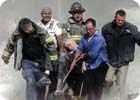
The body of Father Mychal Judge is carried from the World Trade Center on September 11, 2001.
Photo by Shannon Stapleton
Photo by Shannon Stapleton
It was about 8:50 a.m. on Sept. 11 when word reached West 31st Street about the tragedy in lower Manhattan. The thick, black smoke was already billowing skyward. At Engine Co. 1/Ladder Co. 24, the firefighters climbed into their gear and headed downtown.
Across the street at the Church of St. Francis of Assisi, Mychal Judge did the same, according to a Web site dedicated to the “fireman’s friar.”
Father Brian Carroll, O.F.M., went up to Father Judge’s room to inform him that a plane had just crashed into one of the World Trade Center towers. Father Carroll recalls that Father Judge quickly took off his Franciscan habit, changed into his chaplain’s uniform -- paused to comb and spray his hair-- and headed for the door.
The trip from the firehouse to the friars’ residence is maybe two dozen steps. It was a trip that Father Mike -- as he was known among both the homeless and the famous -- made many times since becoming the Fire Department of New York chaplain in 1992.
That morning, as thousands of New Yorkers ran for their lives toward midtown, Judge jumped in his Fire Department car. With firefighter Michael Weinberg at the wheel and the siren wailing, they sped downtown toward the World Trade Center.
He arrived at the burning 110-story towers, where Mayor Rudolph W. Giuliani spotted him.
“Mayor Giuliani recalls that they were both down there very early in the event and the mayor saw him run by with the firemen,” said Father Michael Duffy. “Giuliani says he grabbed his arm and stopped the friar, saying, ‘Mychal, please pray for us.’ And Mychal just looked at him with a big grin and said, ‘I always do!’ And then he turned and ran off with his firefighters, right to the tower, and that’s where he died.”
It’s been five years since that day when the FDNY Friar and thousands others died in New York, Washington and Pennsylvania. Government, law enforcement and private organizations all have been working on policies, procedures, laws and technologies in America’s war on terrorism.
Here are reports collected by Security Magazine, which sum up just some of the post-September 11th accomplishments.
COMMERCIAL AIRLINER PROTECTION
Northrop Grumman has been selected by the Department of Homeland Security (DHS) for Phase III of the Counter-Man Portable Air Defense System (Counter-MANPADS) program. During the Phase III contract, which is valued at $55.4 million, Northrop Grumman will complete production of 12 Guardian missile defensive systems, modification of 11 MD-10 aircraft and operation of the Guardian systems onboard nine MD-10 cargo aircraft flying in regular commercial service.The Guardian system is a defensive aid using proven military technology to defend against the threat posed by anti-aircraft, shoulder-fired missiles. Once launched, the missile is detected by the Guardian system, which then directs a non-visible, eye-safe laser to the seeker head of the incoming missile, disrupting its guidance signals.
MOBILE COMMAND POST
A national trend toward providing seamless communications for regional public safety agencies took a big step recently when Orange County, Florida and the city of Orlando took delivery of a powerful new mobile communications vehicle. Their new Urban Area Command Post will link up day-to-day and emergency communications, serving the citizens of Orlando, Orange County and the surrounding counties of Brevard, Lake, Seminole, Osceola and Volusia.
It links all types of emergency radio systems in use by public safety agencies. The new Florida vehicle can inter-connect 13 different emergency radio systems, phone systems and data networks used by Orlando, Orange County, and nearby jurisdictions. Inside the specially designed 45-foot command vehicle are nine computerized consoles where radio operators can monitor emergency messages and link separate local radio systems together with the click of a mouse. They can instantly connect police and fire personnel, law enforcement, county government or national agencies to talk together as needed.
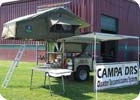
Enterprises are seeing value in the purchase and use of disaster reconnaissance systems that can play a role in situations where infrastructure and communications are limited.
SURVIVAL UNITS
The Disaster Reconnaissance System (DRS), Campa USA, is a highly mobile, all terrain trailer that can provide assistance to emergency management personnel and those in need of a self-contained living unit. “The DRS was designed with the emergency response sector in mind. However, it can be used in many different ways,” said Chris Cole, president and founder of Campa USA. The system, made of stainless steel, can be equipped with features such as a water purification system, 12-volt electrical unit, generator, kitchen and cooking areas, sleeping quarters, solar panels, hot water shower system, compressor, two 22 gallon water tanks, refrigerator, two 10 lb. propane tanks, large storage bins, fluid pump and hand sink.“Often times, there is a communication breakdown between personnel in the field and emergency operation centers,” he said. “Because our units are so mobile, officials will be able to relay critical information from hard-to-reach areas.”

Signage is as important as other approaches to getting the word out on homeland security concerns.
A SIGN OF THE TIMES
Software helps chief security officers create safety, homeland security, lockout/tagout, information and general facility sign-making applications. K-Sun MaxiSigns allows users to design and print professional OSHA-mandated and ANSI/ISO compliant safety signs and tags with any PC compatible desktop printer. Enhancements, such as Homeland Security signs and symbols, add to the wide library of safety pictographs, ergonomic, AED, and recycling symbols, lockout/tagout formats, IMO signs and ANSI/ISO symbols. Additionally, each sign can now be translated into Spanish or Canadian French with the click of mouse button. In fact, the user-friendly software can be configured to provide signs, labels and tags in almost any language once the appropriate fonts are installed.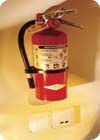
Homeland Security has warned businesses that fire extinguishers could be used as an improvised explosive device. Electronic monitoring of these items makes sense.
EXTINGUISHING TERROR THREATS
In a recent bulletin, Homeland Security noted, “Potentially hard targets such as government facilities, military bases, and airports as well as soft targets such as public buildings need to be protected…IEDs have been found in tires, garbage bags & fire extinguishers.”There is a way to protect and possibly prevent fire extinguishers from ever being used as an IED – that is with electronic monitoring. The technology currently on the market allows for fire extinguishers to be tied into a building’s fire alarm or security system and monitors for presence, pressure and obstruction. More importantly, whenever someone removes an electronically monitored fire extinguisher from its cradle or box, an alarm is immediately sent so that building security can quickly determine if there is a life safety event – such as a fire or theft – taking place.
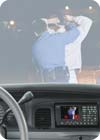
New-age security technology now applies to first responders, such as law enforcement. In-car video recording helps create image databases.
IN-CAR VIDEO AS COUNTER-TERROR TOOL
According to Louis “Lou” Anemone, although 40% of the nation’s police cars are using some form of in-car video, only a small percentage is using digital (law enforcement is currently converting from analog [VHS] to digital). Digital is a preferred method, state of the art for the following reasons: Digital delivers high quality images (especially when recorded in full-VGA); and digital enhances the security and integrity of video, automating chain of custody procedures.Anemone is a 35-year veteran of the New York Police Department. He serves on the Board of Advisors of ICOP Digital, Inc., a surveillance technology company.

Mobile video is a strong weapon in the homeland security battle. Such tools can be used on facility patrol as well as in big cities.
In selecting in-car video solution, it is important that image quality be considered. After all, the video may be required to serve as evidence in court. High-resolution images recorded in full-VGA.
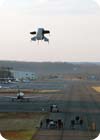
Chief security officers, especially at sprawling campuses, are viewing surveillance drones as a way to patrol the facility.
DRONE PATROLS
The U.S. unmanned aerial systems (UAS) market has had considerable momentum due to recent operational successes and increasing mission roles. In addition, UAS market penetration in all four military services and the commercial sectors in surveillance and weaponized capabilities are driving growth. UAS equipment patrols many military installations and ports; a few private organizations are also using or experimenting with drones as a means of patrolling facilities from above.“On the operational side, UA systems have received praise and support across several services and ranks,” Senior Industry Analyst Kathy Ellwood told Security Magazine. “Testimonies have been documented from many levels regarding the benefits of UA systems in theaters. In fact, those accolades are usually followed by the desire for the delivery of more systems.”
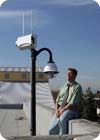
IP cameras can view down to sensitive laptop computers as police monitor Silicon Valley areas.
STAKEOUT DUTY
Police in Milpitas, Calif. have developed an innovative, portable surveillance platform integrating robotic network cameras to provide a high tech update to the traditional (and time consuming) stakeout assignments. Instead of having to camp out on rooftops, police enjoy the same birds-eye view from their office desktops by placing the surveillance platform at crucial locations.“The Sony cameras save the investment in man hours and overtime associated with traditional stakeout teams equipped with binoculars on rooftops,” said Dave Rossetto, commander of special operations for the Milpitas Police Department. “Now, officers can watch from their desks, which allow them to make better use of their time by working on other projects while keeping an eye out for criminal activity.”
Located near the heart of Silicon Valley, Milpitas hosts many high tech professionals who leave their laptop computers in cars as they visit restaurants and retailers in the malls around town. When a team of professional thieves targeted a mall parking lot and stole roughly 11 laptops in a single spree, Rossetto met with Bill Marion, the city’s IT manager, to devise a plan deploying new IP security technology to monitor vulnerable areas. After hearing the commander’s security needs, Marion says he understood what would be a suitable solution and managed to build it in five days. Marion constructed a portable surveillance package with a robotic network camera and digital video recorder accessible through a Tropos 5110 wireless transmitter. When Rossetto saw this creation, Marion says he dubbed it the “Cyclops” and immediately put the unit to work.

Mass transit is a more likely terror target. Video on New York City buses provides both a deterrent and a means of identification.
NEW YORK CITY VIDEO ABOARD BUSES
With an eye toward fighting terrorism and enhancing customer and employee security, MTA New York City Transit has begun a $5.2 million pilot project that will put advanced video surveillance equipment onboard 400 Manhattan buses. If the pilot is successful, cameras could be installed in the entire 4,500 bus fleet.“Video surveillance is a vital part of the Metropolitan Transportation Authority’s ongoing effort to maintain a transit network that is as safe and secure as possible,” said MTA Chairman Peter S. Kalikow. “Utilizing the latest in proven technology, our suppliers are working closely with us to develop the most effective means of securing the MTA transportation system.” The pilot system, created by Integrian, Inc., of Research Triangle Park, North Carolina, will offer a visible crime deterrent, while also providing a state-of-the-art electronic tool that will aid in the investigation and prosecution of criminal activity aboard the vehicles.
